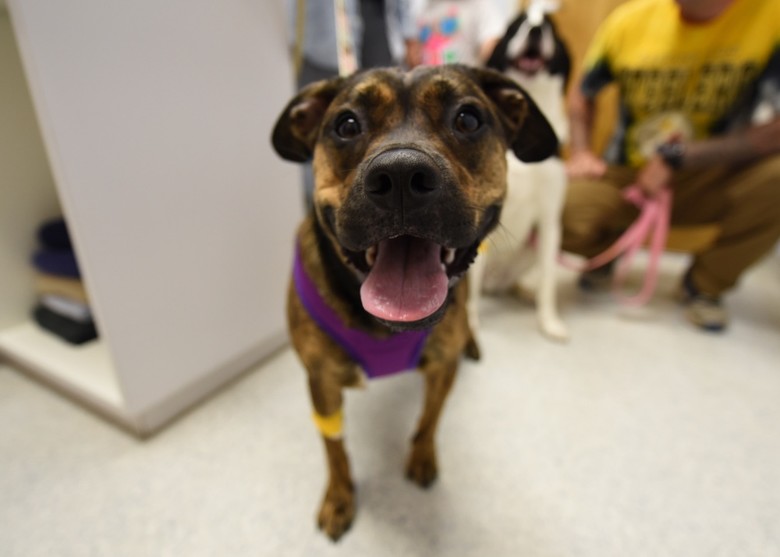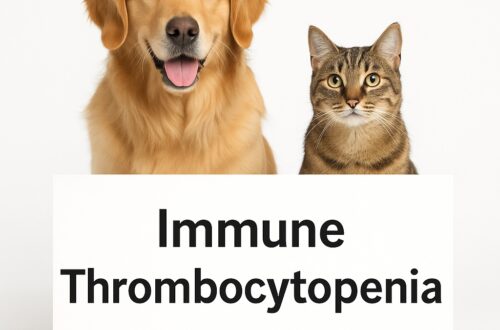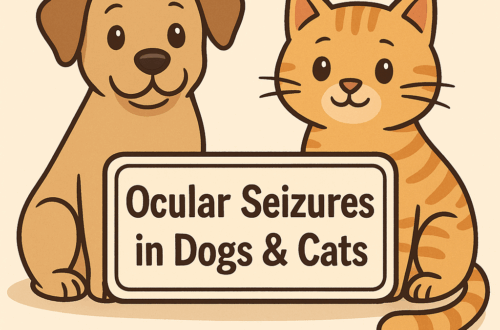Coughing is one of the most common reasons pet owners bring their pets to veterinarians for evaluation. In previous posts, I’ve shared information about some well-recognized causes of coughing, including asthma in cats and “kennel cough” in dogs This week I have information for you about an under-recognized, yet important, cause of coughing: eosinophilic pneumonia. I hope you find the information useful and will share it with other pet owners. Happy reading!
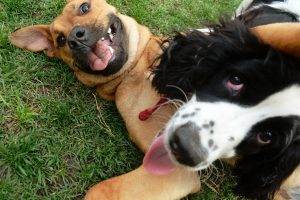
What are eosinophils?
Eosinophils are a type of white blood cell. They are made in bone marrow and are specialized cells of the immune system. Functions of eosinophils are varied and include:
- Movement to inflamed areas
- Trapping substances
- Killing cells
- Anti-parasitic & bactericidal activity
- Participating in immediate allergic reactions
- Modulating inflammatory responses
Eosinophils contain at least four types of granules: primary granules, specific granules, small dense granules, and microgranules. All of the granules contain proteins that are responsible for the varied functions of eosinophils.
The white blood cells shown below are stained with hematoxylin and eosin (H&E). This type of stain is commonly used by board-certified veterinary pathologists to evaluate biopsy samples. Hematoxylin stains the nuclei of cells (aka the control center of the cell where the DNA is located) purple. The eosin stains proteins contained in granules pink. The pink staining is the reason these cells were named eosinophils, which means “eosin loving.”
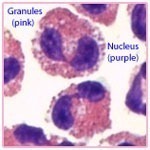
What is eosinophilic pneumonia?
Eosinophilic pneumonia is a term that describes a diverse group of lung disorders, all of which are characterized by increased numbers of eosinophils in the lungs. Major causes are:
- Heartworm disease
- Lungworm infestation
- Fungal infection (e.g.: blastomycosis, histoplasmosis, coccidioidiomycosis)
- Feline asthma
- Eosinophilic bronchitis
- Langerhans cells granulomatosis (aka Histiocytosis X or eosinophilic granuloma)
- Cancers (e.g.: lymphoma, mast cell tumors)
In addition the above-listed diseases, eosinophils can be concurrently increased in the both the bloodstream and other organs. Although rare, this condition is called idiopathic hypereosinophilic syndrome and has been documented in both cats and dogs.
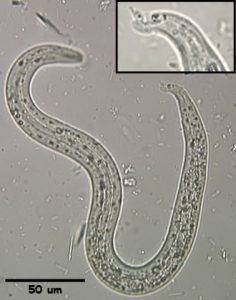
What does is look like?
Patients with eosinophilic pneumonia commonly cough. Coughing is usually mild, persistent, and non-productive. With that being said, some pets cough hard enough to induce a retch immediately after coughing; some dogs and cats may bring up foamy and/or yellow vomitus. This phenomenon is called post-tussive (aka after the cough) retching and should not be confused with true vomiting. Pets with eosinophilic pneumonia may have exercise intolerance and be unwilling to be as active as normal. Occasionally, patients can develop difficulty breathing and require emergency interventions.
As mentioned earlier, idiopathic hypereosinophilic syndrome is rare. Female, middle-aged, domestic shorthair cats are over-represented, as are Rottweilers. Common clinical signs in cats are weight loss, reduced (or loss of) appetite, vomiting, and diarrhea.
How is eosinophilic pneumonia diagnosed?
A veterinarian will first thoroughly review your pet’s medical history and perform a complete physical examination. Then, they’ll recommend some initial non-invasive tests to determine the cause of a patient’s coughing, including:
- Complete blood count
- Serum biochemical profile
- Urinalysis
- Pulse oximetry
- Screening for feline leukemia virus (FeLV) and feline immunodeficiency virus (FIV) – cats only
- Heartworm screening
- Baermann fecal analysis for lungworms
- Fungal disease screening (depending on your geographical location)
- Diagnostic imaging, including chest radiographs/x-rays

Depending on the results of the non-invasive tests, a minimally invasive procedure called tracheobronchoscopy may be recommended. This is a brief procedure performed under anesthesia. A fiber-optic camera is guided through the mouth in the trachea (windpipe) and lower airway branches to visually inspect the tissues. The doctor will collect samples for cytology (cell analysis), culture, and infectious disease screening. Most primary care doctors do not perform tracheobronchoscopy and will recommend families consult with a board-certified veterinary internal medicine specialist who is trained to perform this procedure.
How is it treated?
Veterinary teams will provide supplemental oxygen and airway dilated medications to patients in respiratory distress. These cats and dogs benefit from hospitalization for around-the-clock supportive care. Depending on your family veterinarian’s capabilities, they may recommend you seek care for your pet at your local veterinary emergency hospital.
Effective treatment of eosinophilic pneumonia depends on identifying the underlying cause of eosinophil infiltration into the lungs. Interventions for heartworm disease are different than those for lungworm infestation. Furthermore, treating patients with medicines that modify how the immune system works without first ruling out infectious diseases could cause a pet’s condition to worsen. For this reason, a thorough diagnostic investigation is imperative. Pet owners may find it helpful to partner with a board-certified veterinary internal medicine specialist to develop a logical treatment plan.
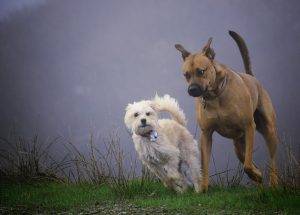
The take-away message about eosinophilic pneumonia?
Eosinophilic pneumonia is an important cause of coughing in both cats and dogs. A thorough diagnostic investigation is important to ensure the most appropriate therapies are prescribed. Prognosis is dependent on the underlying cause and effective interventions.
To find a board-certified veterinary internal medicine specialist, please visit the American College of Veterinary Internal Medicine.
Wishing you wet-nosed kisses,
CriticalCareDVM


